|
|
|
|
|
|
|
|
|
|
|
HOME
CATHAR
BELIEFS
Basic
Tenets
Implications
Cathar
Believers
Cathar
Elect
Afterlife,
Heaven
& Hell
Other
Beliefs
Cathar
Ceremonies
Cathar
Prayer
The
Cathar Hierarchy
CATHAR
WARS
Albigensian Crusade
Who
led the Crusade ?
Crusader
Coats of Arms
Defender
Coats of arms
Medieval
Warfare
CATHOLIC
CHURCH
Cistercians
Dominicans
Franciscans
Cathars
on Catholics
Catholics
on Cathars
Catholic
Propaganda
"Kill
Them All ... "
Waldensians
Troubadours
CATHAR
INQUISITION
Inquisition
Inquisition
documents
CATHAR
CASTLES
Cathar
Castles
Cathar
Castle Photos
CATHAR
ORIGINS
Early
Gnostic Dualism
Manichaeans
CATHAR
LEGACY
Geopolitics
Historical
Studies
Popular
Culture
Catholic
Inheritance
Protestant
Inheritance
Cathar
Vindications
Do
Cathars still exist ?
CATHAR
TOURS
WHO's
WHO
The
Catholic Side
The
"Cathar" Side
Counts
of Toulouse
The
Cross of Toulouse
CATHAR
TIMELINE
Detailed
Chronology
MORE
INFORMATION
CATHAR
TERMINOLOGY
A
Cathar Glossary
|
The Cathars were a religious group who appeared in Europe in the
eleventh century, their origins
something of a mystery though there is reason to believe their ideas
came from Persia or the Byzantine Empire, by way of the Balkans
and Northern Italy. Records from the Roman Catholic Church
mention them under various
names and in various places. Catholic theologians debated
with themselves for centuries whether Cathars were Christian heretics
or whether they were not Christians at all. The question is
apparently still open. Roman Catholics still refer to Cathar belief
as "the Great Heresy" though the official Catholic position
is that Catharism is not Christian at all.
The religion flourished in an area often referred to as the Languedoc,
broadly bordered by the Mediterranean Sea, the Pyrenees, and the
rivers Garonne, Tarn and Rhône -— and corresponding to
the new French region of Occitanie (or the old French regions
of Languedoc-Roussillon
and Midi-Pyrénées)
As Dualists,
Cathars believed in two principles, a good god and his evil adversary
(much like God and Satan of mainstream Christianity). The good principle
had created everything immaterial (good, permanent, immutable) while
the bad principle had created everything material (bad, temporary,
perishable). Cathars called themselves simply Christians;
their neighbours distinguished them as "Good
Christians". The Catholic Church called them Albigenses,
or less frequently. Cathars.
Cathars maintained a Church
hierarchy and practiced a range of
ceremonies, but rejected any idea of priesthood or the use of
church buildings. They divided into ordinary
believers who led ordinary medieval lives and an inner
Elect of Parfaits (men) and Parfaites (women) who led extremely
ascetic lives yet still worked for their living - generally in itinerant
manual trades like weaving. Cathars believed in reincarnation
and refused
to eat meat or other animal products. They were strict about
biblical injunctions - notably those about living in poverty, not
telling lies, not killing and not swearing oaths.
Basic
Cathar Tenets led to some surprising logical implications.
For example they largely regarded men
and women as equals, and had no doctrinal objection to contraception,
euthanasia
or suicide.
In some respects the Cathar and Catholic Churches were polar opposites.
For example the Cathar Church taught that all non-procreative sex
was better than any procreative sex. The Catholic Church taught
- as it still teaches - exactly the opposite. Both positions produced
interesting results. Following their tenet, Catholics concluded
that masturbation was a far greater sin than rape (as mediaeval
penitentials confirm). Following their principles, Cathars could
deduce that sexual intercourse between man and wife was more culpable
than homosexual
sex. (Catholic propaganda on this supposed Cathar proclivity
gave us the word bugger, from Bougre,
one of the many names for medieval Gnostic Dualists)
In the Languedoc, known at the time for its high culture, tolerance
and liberalism, the Cathar religion took root and gained more and
more adherents during the twelfth century. By the early thirteenth
century Catharism was probably the majority religion in the area.
Many Catholic texts refer to the danger of it replacing Catholicism
completely.
Catharism was supported or at least tolerated by the nobility as
well as the common people. This was yet another annoyance to the
Roman Church which considered the feudal system to be divinely ordained
as the
Natural Order (Cathars disliked the feudal system because it
depended on oath taking). In open debates with leading Catholic
theologians Cathars seem to have come out on top. This was embarrassing
for the Roman Church, not least because they had fielded the best
professional preachers in Europe against what they saw as a collection
of uneducated weavers and other manual workers. A number of Catholic
priests had become Cathar adherents (Catharism was a religion that
seems to have appealed especially to the theologically literate).
Worse, the Catholic Church was being held up to public ridicule
(some of the richest men in Christendom, bejewelled, vested in finery,
and preaching poverty, provided an irresistible target even to contemporary
Catholics in the Languedoc). Worst yet, Cathars declined to pay
tithes to the Catholic Church. As one senior Churchman observed
of the Cathar movement "if
it had not been cut back by the swords of the faithful I think it
would have corrupted the whole of Europe."
The
Cathar view of the Catholic Church was as bleak as the Catholic
Church's view of the Cathar Church. On the Cathar side it manifested
itself in ridiculing Catholic doctrine and practices, and characterising
the Catholic Church as the "Church of Wolves". Catholics
accused Cathars of heresy or apostasy and said they belonged to
the "Synagogue of Satan". The Catholic side created some
striking
propaganda. When the propaganda proved unsuccessful, there was
only one option left - a crusade - the
Albigensian Crusade.
The head of the Catholic Church, Pope
Innocent III, called a formal Crusade
against the Cathars of the Languedoc, appointing a series of
military
leaders to head his Holy Army. The first was a Cistercian
abbot (Arnaud
Amaury), now best remembered for his command at Béziers:
"Kill
them all. God will know his own". The second was Simon
de Montfort now remembered as the father of another Simon de
Montfort, a prominent figure in English parliamentary history.
The war against the Cathars of the Languedoc continued for two generations.
In the later phases the Kings
of France would take over as leaders of the crusade, which thus
became a Royal Crusade. Among the many victims who lost their lives
were two kings: Peter
II King of Aragon cut down at the Battle
of Muret in 1213 and Louis
VIII King of France who succumbed to dysentery on his way home
to Paris in 1226.
From 1208, a war of terror was waged against the indigenous population
of the Languedoc and their rulers: Raymond VI of Toulouse, Raymond-Roger Trencavel, Raymond
Roger of Foix in the first generation and Raymond
VII of Toulouse, Raymond Trencavel II, and Roger Bernard II of Foix in the second
generation. During this period
an estimated half-million Languedoc men, women and children were
massacred, Catholics as well as Cathars. The Crusaders killed the
locals indiscriminately - in line with the the famous injunction
recorded by a Cistercian
chronicler as being spoken by his fellow Cistercian,
the Abbot
in command of the Crusader army at Béziers.
  The
Counts
of Toulouse and their allies
were dispossessed and humiliated, and their lands later annexed
to France. Educated and tolerant Languedoc rulers were replaced
by relative barbarians; Dominic Guzmán (later Saint
Dominic) founded the Dominican
Order. Within a few years the first papal Inquisition,
manned by the Dominicans,
was established explicitly to wipe out the last vestiges of resistance. The
Counts
of Toulouse and their allies
were dispossessed and humiliated, and their lands later annexed
to France. Educated and tolerant Languedoc rulers were replaced
by relative barbarians; Dominic Guzmán (later Saint
Dominic) founded the Dominican
Order. Within a few years the first papal Inquisition,
manned by the Dominicans,
was established explicitly to wipe out the last vestiges of resistance.
Persecutions of Languedoc
Jews and other minorities were initiated; the culture
of the troubadours
was lost as their cultured patrons were reduced to wandering refugees
known as faidits. Their characteristic concept of "paratge",
a whole sophisticated world-view, was almost destroyed, leaving
us a pale imitation in our idea of chivalry. Lay learning was discouraged
and the reading of the bible became a capital crime. Tithes were
enforced. The Languedoc started its long economic decline from the
richest region of Europe to become the poorest region in France;
and the language of the area, Occitan,
began its descent from the foremost literary language in Europe
to a regional dialect, disparaged by the French as a patois.
At the end of the extermination of the Cathars, the Roman Church
had proof that a sustained campaign of genocide can work. It also
had the precedent of an internal Crusade within Christendom, and
the machinery of the first modern police state that could be reconstructed
for the Spanish Inquisition, and again for later Inquisitions and
genocides. Chateaubriand referred to the crusade as "this
abominable episode of our history". Voltaire observed that
"there was never anything as unjust as the war against the
Albigensians".
  Catharism
is often said to have been completely eradicated soon after the
end of the fourteenth century. Yet there are more than a few
vestiges
even today, apart from the enduring memory of Cathar "Martyrdom"
and the ruins of the famous "Cathar
castles", including the spectacular castle at Carcassonne
and the hilltop Château
of Montségur ( Catharism
is often said to have been completely eradicated soon after the
end of the fourteenth century. Yet there are more than a few
vestiges
even today, apart from the enduring memory of Cathar "Martyrdom"
and the ruins of the famous "Cathar
castles", including the spectacular castle at Carcassonne
and the hilltop Château
of Montségur ( Montsegùr).
Montsegùr).
Today, there are still many echoes of influences from the Cathar
period, from International
geopolitics down to popular
culture. There are even Cathars alive today, or at least people
claiming to be modern
Cathars. There are historical
tours of Cathar sites and also a flourishing, if largely superficial,
Cathar tourist industry in the Languedoc, and especially in the
Aude
département.
As we see the eight-hundredth anniversary of important events,
more and more memorials are springing up on the sites of massacres,
as at Les
Casses, Lavaur,
Minerve,
and Montségur.
There is also an increasing community of historians and other
academics engaged in serious historical
and other academic Cathar studies. Interestingly, to date, the
deeper scholars have dug, the more they have vindicated
Cathar claims to represent a survival of an important Gnostic strand
of the Earliest Christian Church.
  Arguably
just as interesting, Protestant
ideas share much in common with Cathar ideas, and there is some
reason to believe that early reformers were aware of the Cathar
tradition. Even today some Protestant Churches claim a Cathar heritage.
Tantalisingly, weavers were commonly accused of spreading Protestant
ideas in the fifteenth and sixteenth centuries, just as their antecedents
in the same trade had been accused of spreading Cathar ideas in
Medieval times. Arguably
just as interesting, Protestant
ideas share much in common with Cathar ideas, and there is some
reason to believe that early reformers were aware of the Cathar
tradition. Even today some Protestant Churches claim a Cathar heritage.
Tantalisingly, weavers were commonly accused of spreading Protestant
ideas in the fifteenth and sixteenth centuries, just as their antecedents
in the same trade had been accused of spreading Cathar ideas in
Medieval times.
It can even be argued that in many respects Roman
Catholic ideas have shifted over the centuries ever further
from the Church's medieval teaching and ever closer to Cathar teaching.
|
|
Pope
Innocent III excommunicates a group of Cathars. From the
fourteenth century, Chronique de France (Chronique de St Denis),
British Library, Royal 16, g VI f374v.
|
 |
| |
|
Defenseless Languedoc Cathars are cut down
by French Catholic Crusaders. From the fourteenth century
Chronique de France (Chronique de St Denis), British Library,
Royal 16, g VI f374v. This is the right hand side of a two
panel illustration (The left half is shown above). In this
panel The leading crusader can be identified by his coat of
arms as Simon
de Montfort .
|
 |
| |
|
The Battle
of Muret (1213), a turning point in the Cathar Crusade
depicted in Grandes Chroniques de France, Manuscript français
2813, fol. 252v. (created 1375-1380), in the Bibliothèque
nationale de France
|
 |
| |
|
Auto da Fe Presided Over By Saint
Dominic Of Guzmán (1475); Pedro Berruguete (around
1450-1504) commissioned by fellow Dominican
Torquemada, Oil on wood .
60 5/8 x 36 1/4 (154 x 92 cm).
Now in the Museo del Prado, Madrid.
|
 |
| |
|
The Aude departement brands itself as "Cathar
Country"
|
 |
| |
|
Château Comtal, Carcassonne
|
 |
| |
|
|
|
|
|
|
Around 1250 Alphonse de Poitiers wrote to
Pope Innocent IV asking him to issue a bull against heresy.
This document is known in the form of a draft, on the back
of which is a sketch showing a man being burned at the stake.
Alphonse's draft letter is held in the French
National Archives, in a dossier called "Grands documents
de l'histoire de France; Florilège", No
notice 00000192, Fonds MUS, Cote AE/II/257 (Cote origine J428/1):
described as "Projet de texte rédigé pour
Alphonse de Poitiers, comte de Toulouse, afin d'obtenir du
pape Innocent IV une bulle sur les poursuites contre les hérétiques.
Au verso figure le dessin d'un hérétique livré
aux flammes. Document non daté, en latin."
|
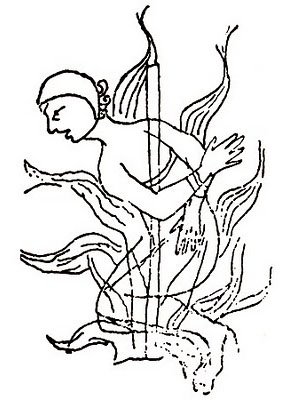 |
| |
|
Bible moralisée Oxford-Paris-London
BNF Lat11560 f1v (Job) showing Franciscans
watching a
Cathar Consolamentum
|
 |
| |
|
Franciscans
watching a
Cathar Consolamentum
|
 |
| |
|
Jean-Paul Laurens (1838-1921)
La Délivrance Des emmurés de Carcassonne,
1879
oil on canvas ( 115 cm c 150 cm)
Musée Des Beaux Arts, Carcassonne,
France
|
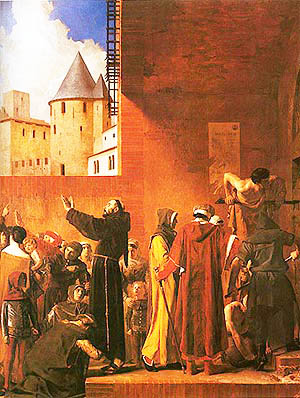 |
| |
|
Trencavel
seal reproduced in stone in Béziers
|
 |
| |
|
Road sign commemorating a Cathar Council
at Pieusse
|
 |
| |
|
Carcassonne
- Château Comtal
|
 |
| |
|
Villerouge
Termenes - staircase built within the thickness of a tower
wall
|
 |
| |
|
Medieval window seat at Villerouge
Termenes where the last known Cathar
Parfait in the Languedoc was burned alive for disagreeing
with Catholic theology.
|
 |
| |
|
Montsegur,
where around 325 Cathars were burned alive in 1244 for disagreeing
with Catholic theology
|
 |
| |
|
Saint
Augustine of Hippo - an ex Manichaean
Sometimes called the "Father of the Inquisition"
|
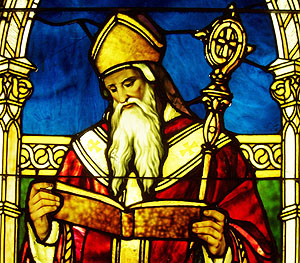 |
| |
|
Donjon
d'Arques
|
 |
| |
|
Capitol, Toulouse
|
 |
| |
|
Commemorative plaque at Lavaur
where around 400 Cathars were burned alive for disagreeing
with Catholic theology.
|
 |
| |
|
Pope
Innocent III with Raymond
VII, Count
of Toulouse
|
 |
| |
|
Memorial at Les
Casses where 60 Cathars were burned alive
|
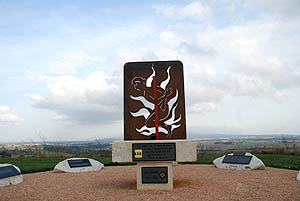 |
| |
|
Figure on the Basilica at Carcassonne
|
|
 |
|
| |
|
The King
of Aragon wearing his "Coat
of arms"
|
 |
| |
|
|
Cité of Carcassonne
|
 |
| |
|
Lotario di Segni became Pope
Innocent III in 1198
|
 |
| |
|
Raymond
VII, Count
of Toulouse
submitting to Louis IX, The
King of France
|
 |
| |
|
Seal of Jeanne of England,
wife of Raymond VI, Count
of Toulouse
mother of Raymond
VII, Count
of Toulouse
|
 |
| |
|
Seal of Jeanne of England,
wife of Raymond VI, Count
of Toulouse
mother of Raymond
VII, Count
of Toulouse
|
 |
|
Note the Cross of Toulouse
|
 |
| |
|
Seal of Jeanne of England,
wife of Raymond VI, Count
of Toulouse
mother of Raymond
VII, Count
of Toulouse
|
 |
| |
 |
| |
| |
|
The Counts
of Toulouse are popular
among medieval re-enactors
|
 |
| |
|
Trencavel
seal reproduced in stone in Béziers
|
 |
| |
| |
 |
| |
|
The start of the Litury of the Consolamentum
from the Cathar Rituel in the Lyon MS.
|
 |
| |
| |
 |
| |
|
Vestiges of "the Wall" - the Inquisition
prison at Carcassonne
|
 |
| |
| |
|
Illustration from the illuminated manuscript
Grandes Chroniques de France depicting the burning of Amalrician
heretics before King Philip II of France. In the background
is the Gibbet of Montfaucon and, anachronistically, the Grosse
Tour of the Temple fortress. Jean Fouquet (1455-1460), Bibliothèque
nationale de France, Paris
|
 |
| |
|
A woman (allegorically representing the Gospel)
with a thunderbolt triumphing over Heresia (Heresy) and the
Serpent (Satan). Church of King Gustaf Vasa, Stockholm, Sweden,
sculpture by Burchard Precht.
|
 |
|
|
Auto DA Fe Presided Over By Saint
Dominic Of Guzmán (1475); Pedro Berruguete (around
1450-1504) commissioned by Torquemada, Oil on wood . 60 5/8
x 36 1/4 (154 x 92 cm).
Now in the Museo del Prado, Madrid.
Detail - Cathars to be burned
|
 |
| |
|
Burning Cathar "heretics" at Montsegùr
|
 |
| |
|
Road sign in Béziers
|
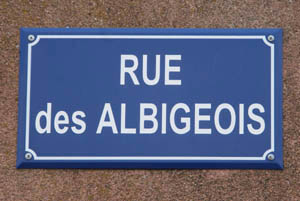
|
| |
|
Jean-Paul Laurens (1838-1921)
The Agitator of Languedoc, 1882
oil on canvas ( 115 cm c 150 cm)
Musée Des Augustins, Toulouse,
France
(depicting the Franciscan
Bernart de Liegosi, better known by French version of his
name Bernard Délicieux, facing the Inquisition)
|
| |
|
Puilaurens
|
 |
| |
|
Tours
of Cathar Castles & Cathar Country
|
 |
| |
|
Memorial at Minerve
where 140 - 180 Cathars were burned alive for disagreeing
with Catholic theology.
|
 |
| |
|
Cathar street sign in the Languedoc.
|
 |
| |
|
Villerouge
Termenes where the last known Cathar
Parfait in the Languedoc was burned alive in 1321 for
the crime of disagreeing with Catholic theology.
|
 |
| |
|
Barbican, Aude Gate, Carcassonne,
besieged in 1209.
|
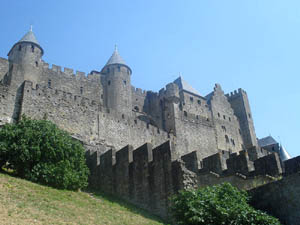 |
| |
|
Donjon
d'Arques
|
 |
| |
|
Toulouse
|
 |
| |
|
Commemorative plaque at Lavaur
where around 400 Cathars were burned alive for disagreeing
with Catholic theology.
|
 |
| |
|
"Kill
them all. God will know his own"
|
 |
| |
|
Painting in the Halle des Illustres at Toulouse
depicting the death of Simon
de Montfort
|
 |
| |
|
Medieval Trebuchet stones (at Carcassonne)
|
 |
| |
|
Raymond IV, window (detail)
in the Cathédrale Notre Dame & Saint Castor, Nimes
|
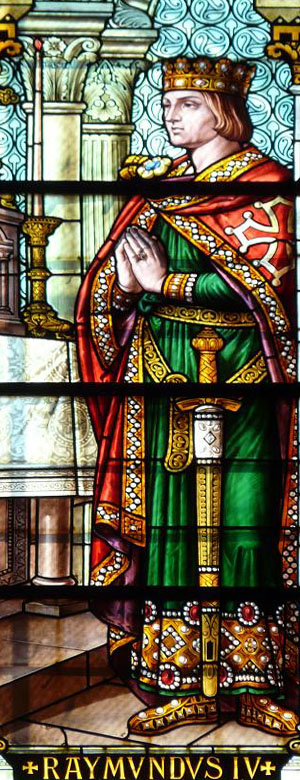 |
| |
|
The
King of France wearing his "Coat
of Arms"
|
 |
| |
|
|
Raymond
VII, Count
of Toulouse
submitting to Louis IX, The
King of France
|
 |
| |
|
Montsegur
|
 |
| |
|
Burning Heretics
|
 |
| |
|
Dominicans
copied many aspects of Cathar practice, including the wearing
of black outer robes.
|
 |
| |
| |
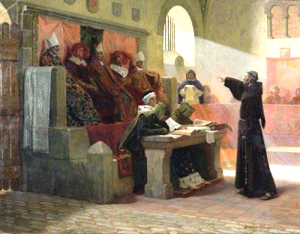 |
| |
|
Cathars and Catholics Expelled
from Carcassonne
by the Crusaders
(Expulsion of the Albigensians from Carcassonne,
a product of the Workshop of Master of Boucicaut, Grandes
Chroniques de France, c. 1415, British Library
|
 |
| |
|
Confrérie Des Chevaliers Cathares
|
 |
| |
|
Commemorative Road Sign at Minerve
where 140 - 180 Cathars were burned alive for disagreeing
with Catholic theology.
|
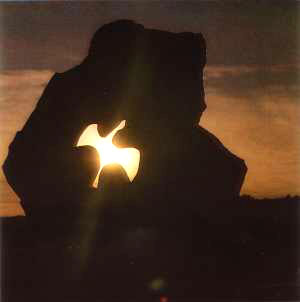 |
| |
|
Cathars (Catari) flourished in Italy too
Road sign in Sirmione, Italy
|
.jpg) |
| |
|
Arnaud
Amaury, other Cistercian abbots and St-Dominic.
(with a halo) crush helpless Cathars underfoot - a sanitised
version of the persecution of the Cathars
|
 |
| |
| |
 |
| |
|
Torture museum in in the Logis de l'Inquisition
- the old Dominican house in Carcassonne
|
 |
| |
|
Memorial at Minerve
where 140 - 180 Cathars were burned alive for disagreeing
with Catholic theology.
|
 |
| |
| Raymond VI by Jean-Paul Laurens, c 1920. The picture represents
the spirit of independance of Occitan civilisation (for no obvious
reason this picture has been withdrawn from public display in
the Salle des Illustres in the Capitol, Toulouse. |
 |
| |
|
Cathars and Catholics Expelled
from Carcassonne
by the Crusaders
(Expulsion of the Albigensians from Carcassonne
(detail), Grandes Chroniques de France, c. 1415, British Library)
|
 |
| |
|
|
Auto DA Fe Presided Over By Saint
Dominic Of Guzmán (1475); Pedro Berruguete (around
1450-1504) commissioned by Torquemada, Oil on wood . 60 5/8
x 36 1/4 (154 x 92 cm).
Now in the Museo del Prado, Madrid.
Detail - Cathars being burned
|
 |
| |
|
Queribus
|
 |
| |
|
Carcassonne
|
 |
| |
|
Puilaurens
|
 |
| |
|
Barbican, Aude Gate, Carcassonne
|
 |
| |
|
Eastern (Uyghur) Manichaeans
writing (with panel inscription in Sogdian). 8th or 9th century
Manuscript from Gaochang, on the northern rim of the Taklamakan
Desert in what is now Xinjiang, China (up to the nineteenth
century Cathars were thought to be Manichaeans)
|
 |
| |
|
Saint
Dominic and the Albigenses, 1480, Pedro Berruguete (Museo
del Prado).
|
 |
| |
|
Raymond IV, Count
of Toulouse, the first man to take the cross in 1095 for
the First Crusade to the Holy Land.
|
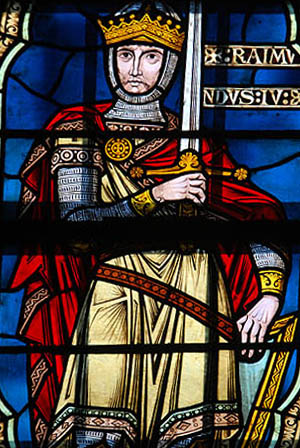 |
| |
|
Nicola Pisano, Cathar "heretics"
before Saint
Dominic the (fictitious) Dispute of Fanjeaux
|
 |
| |
|
|
Béziers
where the Abbot-Comander Arnaud
Amaury reported killing 20,000 without regard to age,
sex or rank.
|

|
|
Flags in Béziers.
These flags are those of the ancient Counts of Toulouse.
|
 |
| |
|
Road sign in Béziers
|
 |
| |
|
The Count
of Toulouse wearing his "Coat
of arms"
|
 |
| |
|
A modern recreation of the Cathar
Ceremony of the
Consolamentum
|
 |
| |
|
Montsegur
|
 |
| |
|
Catholic sources report a number of incidents
of Cathars and others worshipping Satan in the form of a cat,
which then climes a rope and disappears leaving a foul smell.
|
 |
| |
|
The Counts
of Toulouse are popular
among medieval re-enactors
|
 |
| |
|
Battle of Bouvines, 1214
|
 |
| |
|
Imprisoned
|
 |
| |
|
Dame Guiraude being murdered by the Crusaders
at Lavaur
|
 |
| |
|
Devil and the cat worshippers kissing the
cat’s backside Jean Tinctor, Traittié du crisme
de vauderie (Sermo contra sectam vaudensium), Bruges ca. 1470-1480
(Paris, BnF, Français 961, fol. 1r)
|
 |
| |
|
The Languedoc Cross (from the armourial bearings
of the Counts of Toulouse). Often erroneously referred to
as the "Cathar Cross"
|
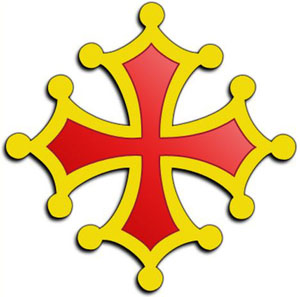 |
|
The Languedoc Cross (from the armourial bearings
of the Counts of Toulouse) may be seen everywhere in the Languedoc
|
 |
| |
|
The Cathar New Testament - Lyon MS
|
 |
| |
|
Saint
Augustine of Hippo - an ex Manichaean
Sometimes called the "Father of the Inquisition",
debating about death of living creatures with the Manichaeans
(Augustine, La Cité de Dieu, Books I-X (translation
from the Latin by Raoul de Presles), Paris, Maître François
(illuminator); c. 1475-1480. Volume II: Nantes, BM, fr. 8
Fol. 25r, Book 1, 20)
|
 |
| |
|
Château
of Foix, seat of the Counts of Foix
|
 |
| |
| Montsegur |
 |
| |
|
The Counts
of Toulouse are popular
among medieval re-enactors
|
 |
| |
| |
 |
| |
| |
 |
| |
|
A Cathar idea echoed by Shakespeare.
Ariel, The Tempest, Act 1, Scene 10
|
 |
| |
|
An arresting modern way of stating the principal
dualistic teaching of the Cathars.
|
 |
| |
|
"Nothing is more cruel to the past than
the commonplace according to which force is unable to destroy
spiritual values; according to this opinion, the existence
of civilizations effaced by the violence of arms is denied.
One may without fear deny the dead. One kills a second time
what has perished, and associates oneself with the cruelty
of arms."
"Rien n'est plus cruel envers le passé
que le lieu commun selon lequel, la force est impuissante
à détruire les valeurs spirituelles ; en vertu
de cette opinion, on nie que les civilisations effacées
par la violence des armes aient jamais existé ; on
le peut sans craindre le démenti les morts. On tue
ainsi une seconde fois ce qui a péri, et on s'associe
à la cruauté des armes."
Simone Weil, under the pen-name Emile Novis,
L'agonie d'une civilisation, Le Génie d'Oc,
n° spécial des Cahiers du Sud, Marseille, 1943
|
 |
| |
|
| Ratification of the Trteaty of Paris, 12 April 1229 |
 |
|
|
A modern recreation of the Cathar
Ceremony of the
Consolamentum
|
 |
| |
|
Detail from Blanche of Castile and King Louis
IX of France in the Bible moralisée de Tolède,
dite bible de Saint-Louis, scène de dédicace,
circa 1220-1230, The Morgan Library & Museum, Accession
number M240
|
 |
| |
| |
|
|
|
Further Information on Cathars and Cathar Castles
|
|
|
|
|
|
|
If you want to cite this website in a book
or academic paper, you will need the following information:
Author: James McDonald MA, MSc.
Title: Cathars and Cathar Beliefs in the Languedoc
url: https://www.cathar.info
Date last modified: 8 February 2017
If you want to link to this site please see
How
to link to www.cathar.info
For media enquiries please e-mail james@cathar.info
|
|
|
|
|
|
|

|
|
|
|
 |
|
|
|
 |
|
|
|
|
|
|
|
|
|
|
|
|
|
|
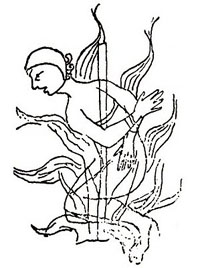









































































.jpg)










































